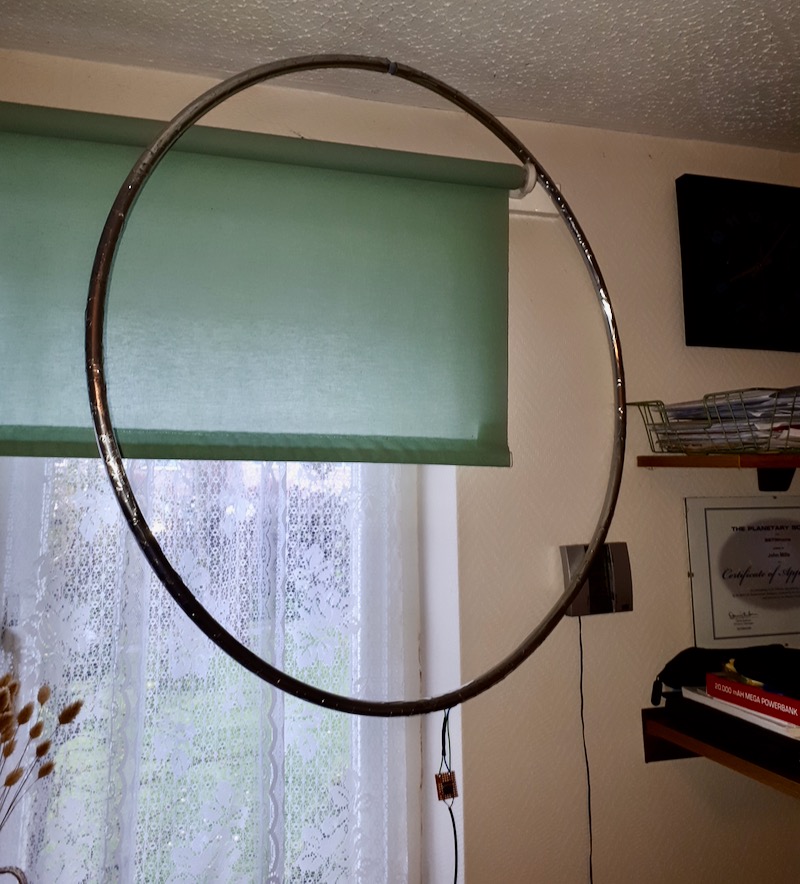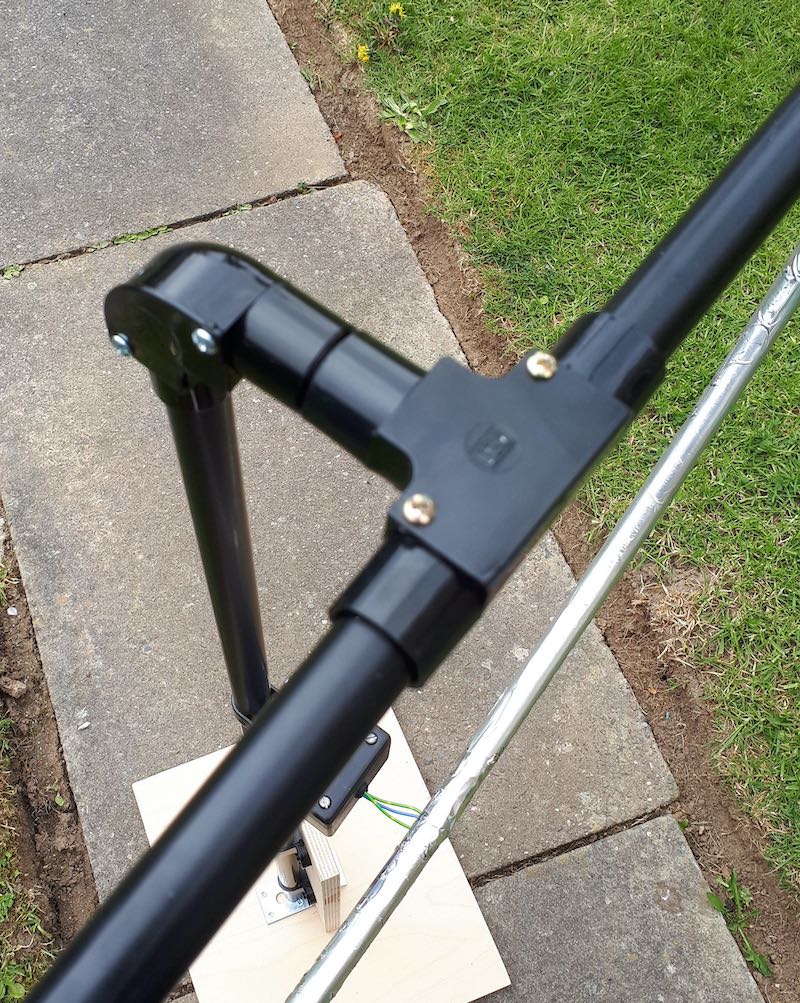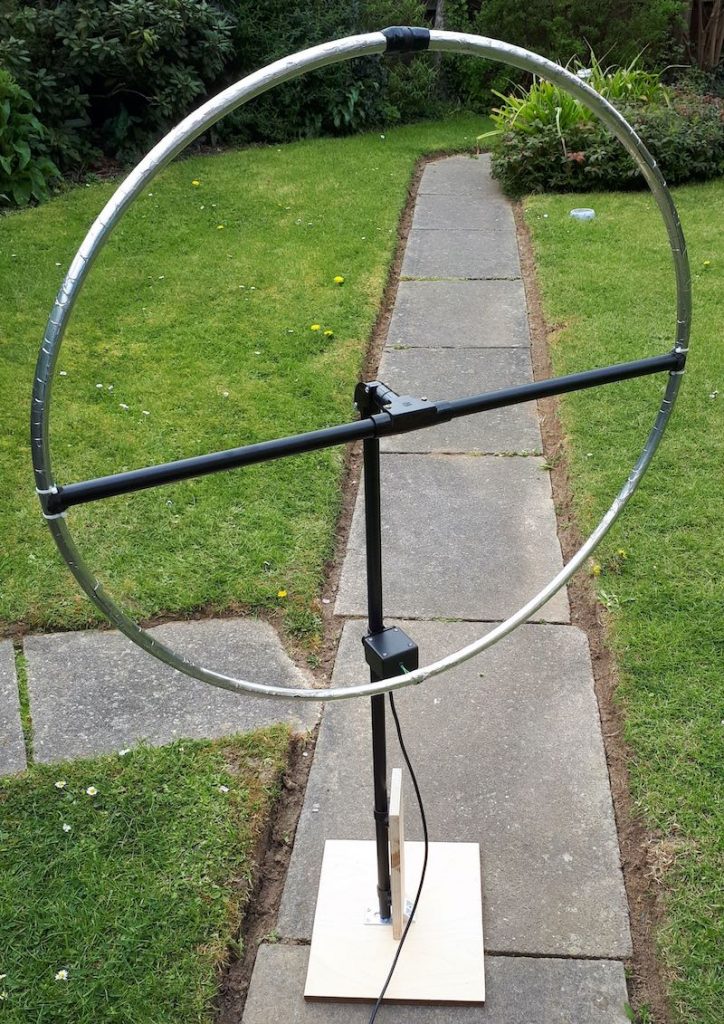 A couple weeks ago, we featured John Mills’ homebrew Noise-Cancelling Passive Loop (NCPL) antenna (see photo above) in a post with two other Post community designs.
A couple weeks ago, we featured John Mills’ homebrew Noise-Cancelling Passive Loop (NCPL) antenna (see photo above) in a post with two other Post community designs.
John recently shared an update to his project:
As promised, some more pictures of my antenna mounted on a rotatable stand. I have used standard (in the UK) 20mm electrical plastic conduit and fittings to make the frame.
Fitted a small plastic box to house the balun and have put a BNC socket on the underside of it for connection the coax cable to my Rx.
I have also been experimenting with cheap low cost amplifiers (LNA) found on eBay (see picture) which do seem to improve the general strength of signals by 10-15db, but the baseline noise also rises.
I did manage to hear a QSO on 160M using one of these which was inaudible without the LNA but I cannot say for sure yet if they are worth the extra noise introduced.
Thank you for sharing your update, John! The plastic conduit support is simple and effective! Indeed, it looks very professional. What I love about your NCPL build (loop, stand, and LNA) is it that it’s all incredibly affordable as well.
Read more about John’s NCPL build in this post.
Post Readers: Has anyone else experimented with implementing a pre-amp in their NCPL antenna design? Please comment!
Do you enjoy the SWLing Post?
Please consider supporting us via Patreon or our Coffee Fund!
Your support makes articles like this one possible. Thank you!





Reading the post, it sounds like the small box sitting at the bottom of the loop hosts the 1:1 transformer, while the LNA is sitting (I suppose) at the RX end; if that’s the case, I suggest to run a little and quick “experiment”
Bring the LNA to the antenna and connect it between the 1:1 transformer and the coax feedline, power it using a 9V battery (for a test it should suffice) and ensure to connect a short run of good diameter insulated wire between one of the “holding screw” eyelets at the corners of the board to a ground stake, that alone should tame your noise quite a lot and allow you to some signal boost without raising the noise floor too much
If you’ll try it, please post here your results !!
Forgot, given that you seem to have some room in your yard/garden, give this one a spin
http://www.kk5jy.net/LoG/
it’s just a relatively short run of wire sitting ON the ground (not above it), so it won’t be an obstacle; the transformer can be wound using the same binocular core but using a different ration (6 turns to the wire, 2 turns to the coax); I think that you won’t believe the kind of performance you’ll get from a diamond shaped piece of wire sitting down in the dirt 🙂 !
Oh and if you think it’s just another “miracle antenna”, it isn’t, just have a look here
https://www.youtube.com/watch?v=wMb8i5QajW0
😀
Hi Guys,
Thanks for all your remarks, it was only an experiment after I finished the antenna. The balun is housed in the plastic box and I connected the LNA directly onto the BNC on the box, so it was not at the Rx end. As I said it is early days and the loop is only 2 metres away from my RspDx anyway. If I do take it outside I already have some earth stakes in the ground and I’ll certainly give that a try.
John
Yeah, the MMIC LNA chips in those things aren’t really meant for HF frequencies – they’re almost never characterised below ~50MHz, and tend to get very squirrelly below that in terms of noise and required input & output match. On top of that they’re fairly sensitive to the required power supply bypassing/choking, and the eBay/Ali boards are usually thrown together based on the bare-bones datasheet example without much regard to that (exhibit 1: the pictured amp, which only has a simple series R / shunt C network), or any RF input stabilisation necessary for some of them at the lower end of even their spec’d range (e.g. the old PGA103).
Adding an attenuator on the output helps by providing a fairly stable load and isolating the output from the somewhat complex/uncharacterised receiver load. There’s also usually a quite obvious minimum noise ‘sweet spot’ that varies with supply voltage from type to type and between individual parts. It’s worth trying each one on a variable supply find where that point is – it’s usually pretty discernible even by just S-meter reading.
Correction: the one pictured *does* maybe have an inductor in the power feed (the whiteish component below the resistor in the power feed). The almost-identical one I have that came from China via eBay does not, and neither do several others I’ve seen.
On the whole though, for HF you’re usually better off with even a simple discrete transistor design.
The thing about those little amplifiers is that they’re cheap. The discrete ones are expensive and it is difficult to explain to most people what they’re paying for.
For example, Dallas Lankford’s designs with negative feedback ( http://www.thegleam.com/ke5fx/norton/lankford.pdf ) are more expensive and time consuming to reproduce. It’s not easy to explain why there is so much value to the high second and third order IMD intercepts. You can say the words “low noise” but most people won’t understand where a lot of that noise comes from and why these amplifiers are worth building.
I have tested the same eBay preamp on the similar Airspy YouLoop.
I found padding the output of the preamp with a 10dB attenuator actually helped with overload as tested with a Grundig G3. A better receiver might not need it. I powered the preamp with a 9v battery.
Instead of looking for significant dB gain, basically I am letting the preamp deal with the likely huge impedance mismatch between the antenna and (less than ideal) portable receiver.
The result? I could monitor regional 80m SSB comms from a horrid indoor RF noisy location in the kitchen. Not bad IMO. YMMV, of course.